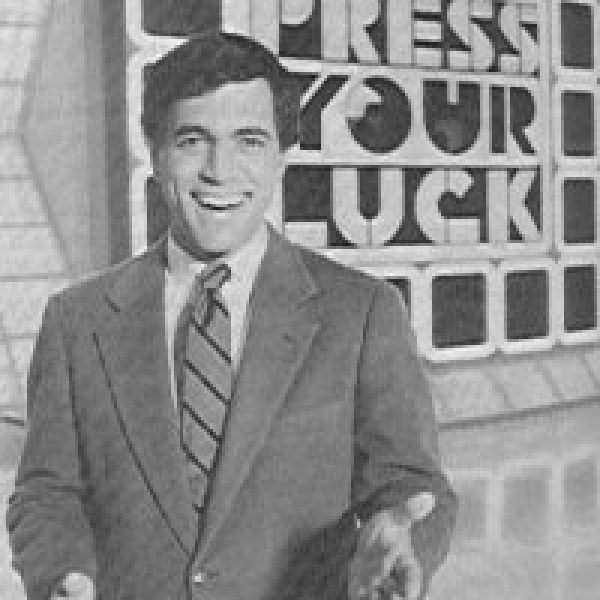If you were not alive and watching daytime game shows in 1984, this video might not mean as much to you. I, however, remember watching this broadcast when I was a kid and not understanding what a big deal this was. Let me bring you up to speed before we look at the video.
Press Your Luck was a game show in 1984 and it gave away more money than the rest. To play, you did a silly trivia round to get spins. The real part of the game was when you used those spins on the big board shown in the background here:
Each TV on the board would flash up different prizes and the lights around the TV’s would “randomly” (scare quotes intentional) move from one screen to another. The players would hit a button to stop the lights and win whatever was lit up. One in six of the screens would have a Whammy. The Whammy would zero out your score. That was the basic mechanics of the game.
How is this related to poker? Well, there was a man named Michael Larson who studied the game intently and realized the “random” progression of lights around the board was anything but random. There were five sets of patterns and once you recognized the pattern and were calibrated to the timing, you could choose when to hit the button such that you got the prize you wanted. The prize Michael wanted was always one where he got money and an additional spin. This wasn’t too hard because two of the TV screens always showed an amount of money and a free spin. Michael found himself a money printing press. He took advantage of it to the tune of $110,000 in 1984. That is a quarter of a million in today’s dollars.
This video talks in detail about the whole thing. Those of you interested in advantage gambling will enjoy it.
So, how did it remind me of poker?
Preparation:
Michael prepared for this game like a professional. Watching the interviews with the other people that were on the show with him, it became obvious that the other players, the Press Your Luck Fish, thought of the game as a fun way to gamble on TV. One of them had only seen the show on TV once. They had no preparation, and they did no better than chance. I am sure this is a thing you recognize from playing live. Some people think poker (and Press Your Luck) is just like craps, the money wheel, or blackjack. It is a fun way to gamble.
Not Michael.
He tirelessly watched and recorded old episodes until he understood the patterns. He knew exactly what would happen when those lights started flashing. Unlike in the game show, in poker, “random” really is random, but preparation makes us winners.
Disguise and Calibration:
Michael did not announce that he was a Press Your Luck shark. He really just remained kind of quiet about it during the interview to get on the show. He tried to play the part of the normal contestant in the first round. In the first round there are no squares that give you money and a free spin. Michael used this time to calibrate his timing. In fact, in his first spin he overshot his target and got a Whammy. He looked like any other contestant on the small round. He quickly calibrated to the timing of the board after this initial failure.
This is a lot like nitting it up and observing on our first few orbits at a new table.
Forget deception once the pot gets big:
Once he got to the second round where the money plus spin prizes appeared, he was ready, and there was no pretense. Where most people hit the plunger with one hand, he had two interlocked hands to make the timing more precise. He was not shouting out the phrases “No Whammy”; he was in the zone. He was quiet and focused on the action. He scored exactly what he wanted to. Once he got to $100k, he used the rule that allowed him to pass his remaining spins to another player.
After watching a master at work, you saw the people relying on luck quickly squander their opportunity when they got these spins. It was so striking to watch one unprepared person rely on luck and struggle where the prepared person made it look effortless.
Exhaustion:
At the end, Michael was passed back three spins. He was clearly exhausted from the high stakes game he was playing. One misstep and he hits a Whammy and loses it all. He quickly used up these required spins. On the final spin he actually got the timing wrong but did not get Whammied. He knew when to walk away.
When I was at the WSOP this year, I was in a game way too long because the fish to my right was just too full of cash for me to leave. I was exhausted — I had been waiting to felt him all day.
I had my chance. He had top pair top kicker while I had middle set. He called my raise on the flop. He called my barrel on the turn. That was it. Why no river shove? I was so tired that I did not see the dealer put out the final card. When I looked at the board I saw the river card was out, I figured, “Oh, that last bet must have been on the river” so I showed my hand. I left $1200 in value on the table because Villain admitted he would have felted if I had shoved the river.
Sleep is no substitute for coffee, but I racked up a few minutes later anyways. Thankfully, it was missed value instead of felting myself. When it is time to go, you should go.
Conclusion:
It was beautiful watching someone prepare for a game and win. In the above documentary, the two opponents on the game were told how Michael had done it. They taught these two what the patterns were and put them in a simulated game. One of them was able to reproduce the results Michael had. A little bit of coaching turned these “Press Your Luck Fish” into sharks. If you are going to play the game, play it to win. That takes preparation and is why we are all here.


That was absolutely great and very inspirational. Thanks for sharing!